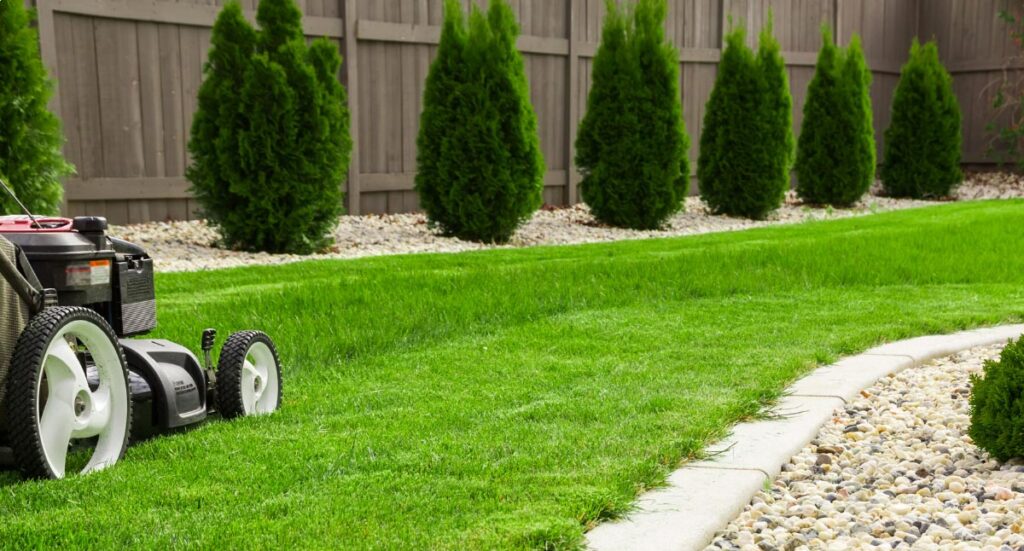
April Gardening Tips
The temperatures are rising, the birds are singing and the sun is shining- Spring is here! The weather, rather than the calendar, dictate when to start working in your garden.
Specimen plants, like Japanese Maples or Evergreens, serve as focal points in the landscape to emphasize their form, texture or color. Some put on an extra show in spring, others display their dramatic colors in fall, but no matter the season, these superstars never fade into the background. Here are a few of our favorites.
Japanese Maples
Bloodgood
Acer palmatum ‘Bloodgood’

One of the most popular Japanese maple varieties, deep purple leaves emerge in spring and mature to a deep burgundy all summer. In fall, the palm-shaped leaves turn a brilliant red.
Plant in full sun to part shade. It goes 15 to 20 feet tall and wide.
Crimson Queen
Acer palmatum ‘Crimson Queen’

Height: 8 – 10 feet
Spread: 10 – 12 feet
Light: Full Sun to Part Shade
Zone: 5 – 8
Crimson Queen is a dwarf, rounded tree with a weeping branching habit that adds a graceful texture to the garden. Foliage emerges purple in spring and develops to spectacular shades of red and orange in fall.
Plant in full sun to part shade. It grows 8 to 10 feet tall and 10 to 12 feet wide.
Virdis Laceleaf
Acer palmatum ‘Dissectum Virdis’

This is Crimson Queen’s green twin in habit and form. Its fern-like leaves remain a bright green throughout the season. In fall, they turn a beautiful golden-yellow with hints of red.
Plant in full sun to part shade. It grows 10 to 15 feet tall and wide.
Katsura
Acer palmatum ‘Katsura’

Palm-like leaves emerge yellow in spring and develop to chartreuse during the season. As fall approaches the leaves turn stunning shades of orange. Even in winter the deep purple younger branches and twigs stand out against the older, gray bark.
Plant in full sun to part shade. It grows 10 to 12 feet tall and wide.
Tamukeyama
Acer palmatum ‘Tamukeyama’

Sporting a mounding and weeping form, lacy foliage emerges a beautiful crimson-red fading to a purple-green in summer, then turning stunning fiery shades of red in fall.
Plant in full sun to part shade. It grows 6 to 8 feet tall and 8 to 12 feet wide.
Evergreens
Creeping Blue Spruce
Picea pungens ‘ Glauca Procumbens ‘

This spreading groundcover produces a striking effect when planted to drape over a rock wall or slope. The attractive blue form makes an excellent alternative to ground covering junipers.
Plant is full sun. It grows 1 to 2 feet tall and spreads 6 to 8 feet.
Weeping Alaskan Cedar
Chamaecyparis nootkatensis ‘Pendula’

Height: 15 – 20 feet
Spread: 8 – 12 feet
Light: Full Sun to Part Shade
Zone: 4 – 7
A slender, pyramidal and delicate weeping tree with pendulous branches produces a striking effect in the landscape.
Plant in full sun to part shade. It grows 15 to 20 feet tall and 8 to 12 feet wide.
Fukuzumi Japanese White Pine
Pinus parviflora ‘Fukuzumi’

Height: Irregular up to 6 feet
Spread: Irregular up to 12 feet
Light: Full Sun to Part Shade
Zone: 4 – 7
A slow growing Japanese pine with a unique 45o branching habit gives a windswept character to the landscape. Short, blue-green, twisted needles are attractive when viewed up close.
Dwarf Hinoki Falsecypress
Chamaecyparis obtusa ‘Nana Gracilis’

Height: 3 – 6 feet
Spread: 2 – 4 feet
Light: Full Sun to Part Shade
Zone: 4 – 7
Dwarf Hinoki Falsecypress is a dense multi-stemmed evergreen shrub with a distinctive and refined pyramidal form. Its shell-shaped sprays give it a relatively fine texture with almost ferny, delicate foliage that sets it apart from other landscape plants – ideal for detail uses.

The temperatures are rising, the birds are singing and the sun is shining- Spring is here! The weather, rather than the calendar, dictate when to start working in your garden.

Spring is so close we can smell it. Time to get in the garden and start prepping for the season (once all the snow melts, of course). Forsythia blooms, Robin

Creating an inviting and beautiful landscape can seem like a daunting task. While you may need to put in some sweat equity, it doesn’t have to be an overwhelming process.
© 2022 English Gardens, a Michigan Nursery and Landscaping Center. All Rights Reserved.
Site design by NH Web Design Company Danconia
English Gardens Detroit MI area nurseries & garden centers are not only the areas largest garden nurseries, but they offer the largest selection of products and services found anywhere in the Clinton Twp., Dearborn Heights, Royal Oak, West Bloomfield, Eastpointe, and Plymouth Ann Arbor Michigan regions providing full service garden centers, full service landscaping and landscape design, seasonal holiday stores including their enchanting Christmas Stores, the largest selection of Patio Furniture in Michigan, and most locations even offer a full service in house florist for flower arrangements for every day as well as those special occasions such as wedding flowers, event flowers, sympathy and funeral flower arrangements, prom flowers, and more!
Our nurseries and garden centers have the areas largest selection of plants, flowers, shrubs, annuals, perennials, and patio furniture. Garden supplies are in abundance, with everything from garden tools and accessories, to garden and potting soil, mulches, bagged garden stone, pots and so much more. We have everything you need for your outdoor gardening needs.
Landscaping? Count on the professional landscape contractors and designers at English Gardens to Make Your Property Beautiful! We offer both DIY landscaping assistance and full service landscape design and construction with our in house landscaping company.
Our floral designers can create perfect floral arrangements for weddings, events, funerals, proms and the like. Make the moment beautiful.
Our Christmas Stores in addition to being one of the areas best holiday experiences, are filled with live and life-like artificial Christmas trees, including flocked artificial Christmas trees, and those sometimes hard to come by 9 foot flocked artificial Christmas trees, as well as a large, ready to take home inventory, of 3 foot artificial Christmas trees, 4 foot artificial Christmas trees, 5 foot artificial Christmas trees, 7.5 foot artificial Christmas trees, 9 foot artificial Christmas trees and 12 foot artificial Christmas trees, and all of the other holiday items you need like Christmas lights, decorations, Christmas wreaths & garland of all types, and unique gifts. Make the Holiday beautiful!
English Gardens store by store offerings in the Clinton Twp., Dearborn Heights, Royal Oak, West Bloomfield, Eastpointe, and Plymouth Ann Arbor Michigan areas;
Be sure to visit any one of our Garden Centers for the largest selection of products and services the area has to offer. If you have any questions please call one of our stores directly in Clinton Twp., Dearborn Heights, Royal Oak, West Bloomfield, Eastpointe, and Plymouth Ann Arbor Michigan for friendly, prompt help.
Address
44850 Garfield Rd. at Hall Rd.
Clinton Twp., Michigan 48038
Phone Numbers
Phone: (586) 286-6100
Fax: (586) 286-0033
Address
22650 Ford Rd. at Outer Dr.
Dearborn Heights, Michigan 48127
Phone Numbers
Nursery: (313) 278-4433
Florist: (313) 565-8133
Fax: (313) 278-0459
Address
22501 Kelly Rd. at Nine Mile Rd.
Eastpointe, Michigan
Phone Numbers
Phone: (586) 771-4200
Fax: (586) 771-4894
Address
9900 Ann Arbor Road W.
Plymouth, Michigan
Phone Numbers
Phone: (734) 453-5500
Address
4901 Coolidge Hwy,
Royal Oak, Michigan
Phone Numbers
Phone: (248) 280-9500
Fax: (248) 280-2688
Address
6370 Orchard Lake Rd. at Maple
West Bloomfield Township, Michigan
Phone Numbers
Phone: (248) 851-7506
Fax: (248) 539-4738
Patio Furniture from English Gardens of Michigan
Patio Lounge Chairs
Patio Furniture Showrooms
Bistro Sets
Outdoor Dining Sets
Outdoor Sectionals
Don’t forget to come visit our enchanted Christmas Stores! We have by far the areas largest display of pre-lit and unlit Christmas trees, both Live and Artificial Life-Like Christmas trees in all sizes and varieties, the areas largest selection of Christmas lights in a variety of lengths, sizes, bulb types including energy efficient, and long lasting ,state of the art, LED Christmas lights, Christmas Garland, Christmas wreaths, Christmas decorations, and that perfect gift for that special someone!
Make Christmas Beautiful! Come to English Gardens This Christmas, It’s Fun For The Whole Family!
When it comes to the holidays other than Christmas, you won’t be disappointed, From July 4th, to Labor Day, Columbus Day, Halloween, Thanksgiving, Easter, Mothers and Fathers Day and more, you guessed it, you can count on English Gardens to Make the Holiday Beautiful!
Make the Holidays Beautiful! Come to English Gardens!
At the end of the day, we all enjoy putting a smile on our, and other’s faces, come to English Gardens at any one of our convenient locations and Make Today Beautiful!
Make Today Beautiful! Come to English Gardens!
Where to Buy Frosted Christmas Trees in Michigan
The best artificial Christmas Trees in Michigan
Where to Buy Mini Lit Christmas Trees in Michigan
Choose the right pencil Christmas tree this holiday season